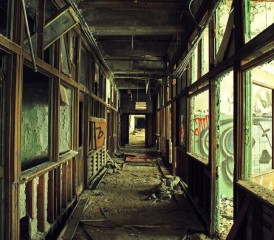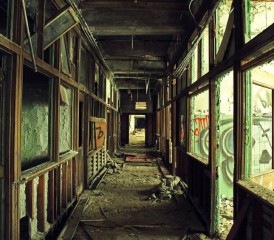Asbestos Exposure Is No. 1 Danger for Urban Explorers
Health & WellnessWritten by Beth Swantek | Edited By Walter Pacheco

Abandoned buildings invite curiosity. What does it look like inside? Why is it abandoned? We want to know.
In recent years, that human inquisitiveness developed into a full-blown hobby for many enthusiasts around the world with a bona fide name, Urban exploration.
The pastime involves unauthorized exploration in abandoned factories, homes, underground tunnels, bridges and towers.
Professional and amateur photographers are among the explorers searching for spectacular sights in decaying ruins, but many fail to protect themselves against exposure to asbestos, a material once commonly used in the construction of buildings.
Some explorers have no idea the hobby may increase their risk of developing mesothelioma, a deadly cancer caused by asbestos, and other asbestos-related illnesses.
Dangers of Capturing Great Pictures
The clandestine visitors in abandoned buildings face a minefield of dangers such as structurally compromised flooring and stairwells, as well as nails and sharp objects underfoot.
However, asbestos ranks as the greatest health threat to urban explorers.

An abandoned Detroit warehouse with exposed building materials poses a risk of asbestos exposure and other dangers.
“Asbestos is absolutely the number one danger for urban explorers, and is often overlooked,” Jason Robinson, founder of the Ohio Exploration Society, told Asbestos.com. “Since asbestos fibers in the air cannot be seen with the naked eye, some urban explorers do not take proper precautions to protect themselves.”
Robinson warned: “The fibers are out of sight, out of mind.”
Asbestos is indeed not a substance to dismiss.
Three thousand new cases of mesothelioma emerge annually in the U.S. alone. The cancer develops after people inhale airborne asbestos fibers. Most people with the cancer survive an average of only one year after diagnosis.
The tiny mineral fibers lodge in lung tissue and eventually cause unrestrained tumor growth. It typically takes 20 to 50 years for mesothelioma to arise after the initial exposure to asbestos.

Asbestos Prevalent in Building Materials
For centuries asbestos was known for its excellent fire retardant properties, but widespread use began during the industrial revolution. Mechanization and new mining methods allowed for greater ease in extracting the naturally occurring mineral from the ground.
The increasing need for cost-effective, mass-produced building materials at the start of World War II continued to drive asbestos use. Manufacturers rampantly used the fiber in a myriad of building products, including roofing, flooring, insulation and adhesives.
By 1977, there were 25 countries producing almost 4.8 million metric tons of asbestos per year, and 85 countries were manufacturing thousands of asbestos-containing products.
It’s no wonder abandoned facilities and structures worldwide often contain asbestos among their ruins.
Explorers Not Always on Their Guard
Maddy Eudy scouts structural relics in Detroit.
The towering Michigan Central Station, ghostly Northville Psychiatric Hospital and long-defunct Packard Plant make the list of her notable expeditions.
When Asbestos.com asked if she takes precautions against asbestos, Eudy responded that asbestos safety isn’t always her top priority.
“There are times when I am more aware of the asbestos in or around an area and other times I’m not,” she said. “I sometimes bring masks for whoever I am with, as well as myself, but sometimes I forget them.”
Professional explorers urge other hobbyists not to take asbestos contamination lightly. They recommend protective clothing and properly fitted respirators on all forays into relics of the past.
New Zealand-based urban exploration website Urbex Central advises explorers to use respirators with asbestos-rated filters, such as the 3M P100 Particulate Filter.
According to the website, “A standard paper dust mask will not protect you from asbestos dust; the asbestos fibers are small enough to pass right through and enter your respiratory tract.”
Robinson agrees.
Thin paper masks or a handkerchief covering your nose and mouth will not do, he said.
Seasoned pros also say explorers need to learn to recognize asbestos in structures in order to avoid it. Wide use of asbestos in flooring, for example, escalates the danger of explorers unknowingly tracking asbestos dust home on their shoes.
Experts recommend removing protective gear outside of the contaminated site, washing it off, and placing it in a sealed bag rather than taking it home and shaking it out.
Toxic Building Materials’ Potential to Harm Twice
Today’s newly diagnosed cases of mesothelioma primarily stem from exposures that happened decades earlier when asbestos use was higher and regulation was more lax.
The tainted building materials languishing in old structures likely passed through the hands of many people who unknowingly breathed in carcinogenic fibers while manufacturing materials or installing them during the original construction of buildings.
These same materials clinging to the now decaying structures maintain their lethal potency and ability to endanger a new population if urban explorers ignore warnings to protect themselves while on their covert adventures.






